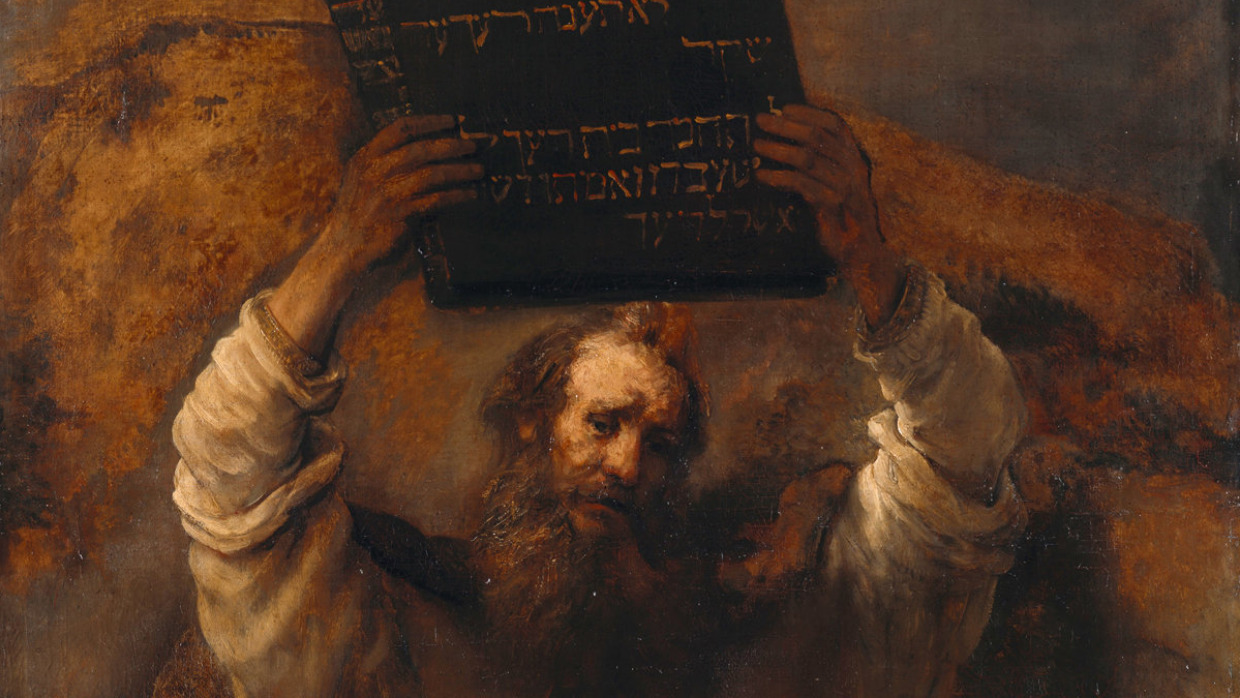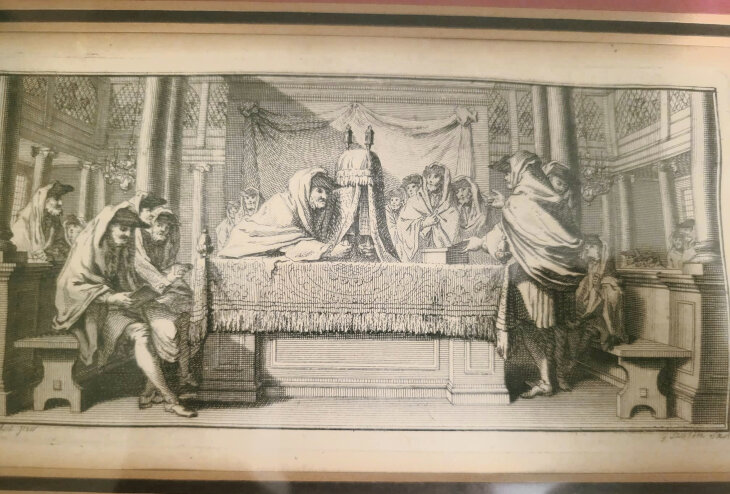 An Open Letter to University Presidents
An Open Letter to University Presidents


9 min read
Three non-Jewish artists who have provided fascinating windows into Jewish life and culture.
Here are three famous non-Jewish artists and some of their exquisite paintings.
Bernard Picart was born in Paris, France in 1673 and took an interest in different cultures and religions from around the world. He collaborated with Jean-Frédéric Bernard, a publisher and produced a series of books entitled “The Book That Changed Europe: Picart and Bernard’s Religious Ceremonies of the World”.
Here are a few etchings that Picart created, depicting wealthy Spanish and Portuguese Jews.
 The Procession of Palmes Of the Portuguese Jews
The Procession of Palmes Of the Portuguese Jews
In this etching, entitled The Procession of Palmes of The Portuguese Jews, Picart depicts a scene of Spanish and Portuguese Jews in Amsterdam during the holiday of Sukkot when, in addition to eating in sukkah huts outside and waving the four species, Jews circle the center bimah in the synagogue, holding the four species and reciting special supplications called Hoshanahs.
In this Spanish and Portuguese congregation, the congregants are dressed in the formal wear of the time, a tricorn hat, a long coat and the traditional tallit (prayer shawl). As the leader, the bearded rabbi in the front is wearing a longer coat than the others. The Torah Scrolls are all dressed in the Spanish and Portuguese mantle which looks white in honor of the holidays.
 Sukkot or Feast of Booths, 1703 ~
Sukkot or Feast of Booths, 1703 ~
In this etching about Sukkot, Picart added all the beautiful accouterments that are typically seen in a Spanish and Portuguese sukkah. The roof is made of leaves with ribbons and paper decorations hanging down. This family is obviously wealthy as can be seen from the ornate chandelier that is also made of leaves and ribbon. The sukkah has three sturdy walls resembling a house, including wall ornaments, showing off this family’s wealth. To the left another family can be seen eating in another sukkah.
Sitting around the table about to eat their festive meal, the men in this picture are dressed in holiday attire, with powdered wigs and hats unlike the stiff tricorns they were in synagogue. The women are dressed for the occasion as well, wearing frilly dresses and jewelry. The scene conveys the warmth and joy of the Sukkot holiday.
 Tallit, Tefillin, and Tzitzit, 1723-25
Tallit, Tefillin, and Tzitzit, 1723-25
Picart did a small diagram of Tallit, Tefillin, and Tzitzit. As an outsider to the Jewish religion, Picart tried his best to depict what the tefillin phylacteries would look like on a male’s arm, showing the Sephardi custom, albeit somewhat inaccurately.
 Spanish Portuguese Congregation in London, 1703
Spanish Portuguese Congregation in London, 1703
Though consistent with Picart’s works, this etching may have been done by Gerard Jean Baptiste Scotin, another French artist who took an interest in other religions as well. This is an etching I have hanging in my house. Being a Spanish Portuguese Jew myself, the artwork intrigued me. This etching depicts a Shabbat day in synagogue. The Torah is dressed in the Spanish and Portuguese mantel that opens in the front and is a cloth wrapping similar to the Ashkenazi mantel. They are getting ready to begin the procession to put the Torah back into the ark. The men are dressed in their white tallit and the crisp tricorns.
 Portuguese Jews Celebrating the Feast of Passover
Portuguese Jews Celebrating the Feast of Passover
Picart’s fascination with the Jews spread to another Jewish holiday, Passover. not as opulent as the family above. Sitting at a round table, this Spanish Portuguese Jewish family seems to live a comfortable life. The room is lit by a small chandelier, candle sconces and a small fire in the hearth.
In the middle of the table there are three plates, the Seder plate was not part of the Spanish and Portuguese tradition. The family seems to be breaking off a piece of the matzah to hide the afikoman. Their haggadahs are open, and the Seder table is set with all the accoutrement they need to get through the Seder.
Rembrandt Harmenszoon Van Rijn, famously known simply as Rembrandt, was an artist during the Dutch Golden Age. His fascination was with light and how to portray it on a canvas. He always had his light off to the side or behind what he was painting, playing around with how it affected his subject and the shadows around them. This technique is known as chiaroscuro.
A religious Christian, Rembrandt lived amongst Jews in Amsterdam and was tolerant of Jews. As a religious person he depicted many biblical paintings.
 Belshazzar’s Feast, 1635 (Wikipedia)
Belshazzar’s Feast, 1635 (Wikipedia)
This painting is of a famous scene that takes place in the Book of Daniel. Rembrandt is depicting King Belshazzar’s feast where he showed off the vessels that his father took from the Temple. In the story, the hand of God came down and started writing on the walls. Daniel, who was a prophet, was called in to read the message the words of God saying your days are numbered.
Dutch artists were very particular with their detailing, as you can see even in the slight glow of God’s presence, the small detailing on Belshazzar’s royal garb. Light hitting his bejeweled garment soaking him in the light of God, stressing that this message was for him.
The stark contrast between light and dark dramatized the scene and emphasized the horror on and shock and the guests faces. Even in the dark shadows, you can see the water being spilled out of the servant's jug in fright and from the cup that Belshazzar tipped with his elbow. The only source of light is from the presence of God’s Hand, putting an emphasis on the words that are being written.
 Moses With the Ten Commandments, 1659
Moses With the Ten Commandments, 1659
The biblical verse says, “As soon as Moses came near the camp and the calf and dancing, he became enraged; and he hurled the tablets from his hands and shattered them at the foot of the mountain'' Exodus 32:19. This painting depicts the famous story of Moses and sin the of the Golden Calf. Rembrandt captures Moses in the midst of throwing the two tablets to the ground. The red around him portrays Moses’ rage.
 Abraham Entertaining the Angels, 1656
Abraham Entertaining the Angels, 1656
Another famous Bible story that Rembrandt magnificently captures is the story of Abraham and the three angels. Abraham was recovering from his circumcision when God sent three angels, traditionally identified as Gabriel, Michael, and Raphael. They were there to heal Abraham and tell him that he and his wife Sarah were going to have a child. Sarah is standing by the doorway listening, before she laughs about the news.
Though the three figures are described simply as men in the Bible, Rembrandt added wings to make their angelic identity clear. He also includes a young boy, Ishmael, in the background. Rembrandt give the boy a bow, in reference to the biblical description of Ishmael as an archer.
Abraham was well known for opening his tent to strangers, giving them a place to eat and rest, his hand gesturing to the three strangers “please, help yourselves”. Again we see here Rembrandt playing with light, Sarah standing in a dark doorway with just enough light to see her.
Henry Ossawa Tanner was an African American artist from Pittsburgh, Pennsylvania. He painted daily life and religious scenes in an expressionist and realistic style. He was the only black student in his college and was favored by the artist Thomas Eakins. According to the Smithsonian, he was the first Black person to achieve international acclaim in the 19th century. His father was a bishop of an Episcopalian Methodist church, and his mother was a former slave who was sent to Pittsburgh through the Underground Railroad. His religious upbringing is reflected in his religious art, for which he is internationally acclaimed.
 Study For Moses and the Burning Bush, 1983
Study For Moses and the Burning Bush, 1983
This beautiful painting depicts the scene of Moses at the burning bush where he hears God speak to him for the first time. The bush is but a spark in the distance and Moses seems to be apprehensively approaching it.
The brush strokes are all a blur, but the detail in the figure stands out, as well as the mountains in the background. Tanner’s use of light is very interesting; Moses is standing in light while the bush is subdued in darkness.
 Moses in the Bullrushes, 1921
Moses in the Bullrushes, 1921
In the beginning of Exodus chapter two, Pharaoh has decreed to kill all baby boys. In order to protect her son, Yocheved, the mother of Moses, places him in a basket in the Nile. Yocheved knew the Egyptians worshiped the Nile and that they would save this baby thinking that he was a gift from the gods. Moses is found by the daughter of Pharaoh who draws him from the water and takes him into the palace and raises him as her son.
In Hebrew, the name Moses means “drawn out” from the water.
This painting depicts Yocheved putting her infant son into the river, with his sister Miriam standing by her side. The river is calm and quiet, with the reflection of the moon clearly shown beside the basket. According to the Smithsonian, it may be the presence of God, leading Moses to his fate of leading the Jews to freedom. The blue captures the stillness of the night and gives off a sad feeling of a mother separating from her son. \
 The Wailing Wall, 1898
The Wailing Wall, 1898
In his travels around the Middle East, Tanner also made stops in Israel. Here he observed the landscapes and costumes of the Jews and the beautiful scenes Israel has to offer. As a Christian it is no surprise that Tanner visited the Wailing Wall, a well-known landmark to many religious groups across the globe.
In the painting, there are men and women praying by the wall, which is the retaining wall of the Temple Mount. Though the color is subdued by the shade, there are gold and red stripes on the garment of the woman standing nearest to us. The man walking towards the audience appears to be a rabbi, with a gray beard, a red long coat and a siddur.
